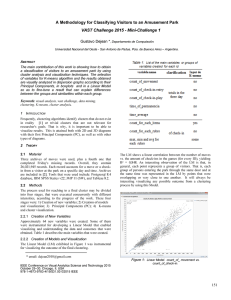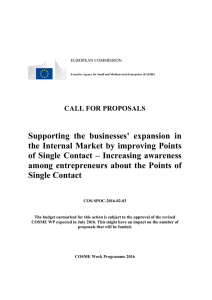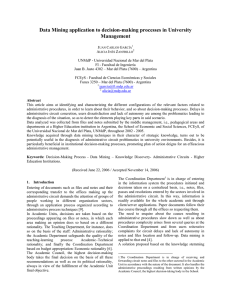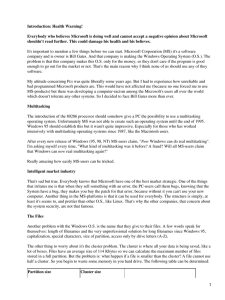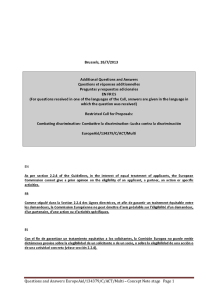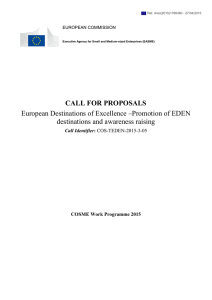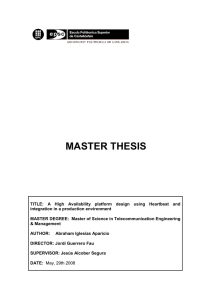Calls for proposals
Anuncio
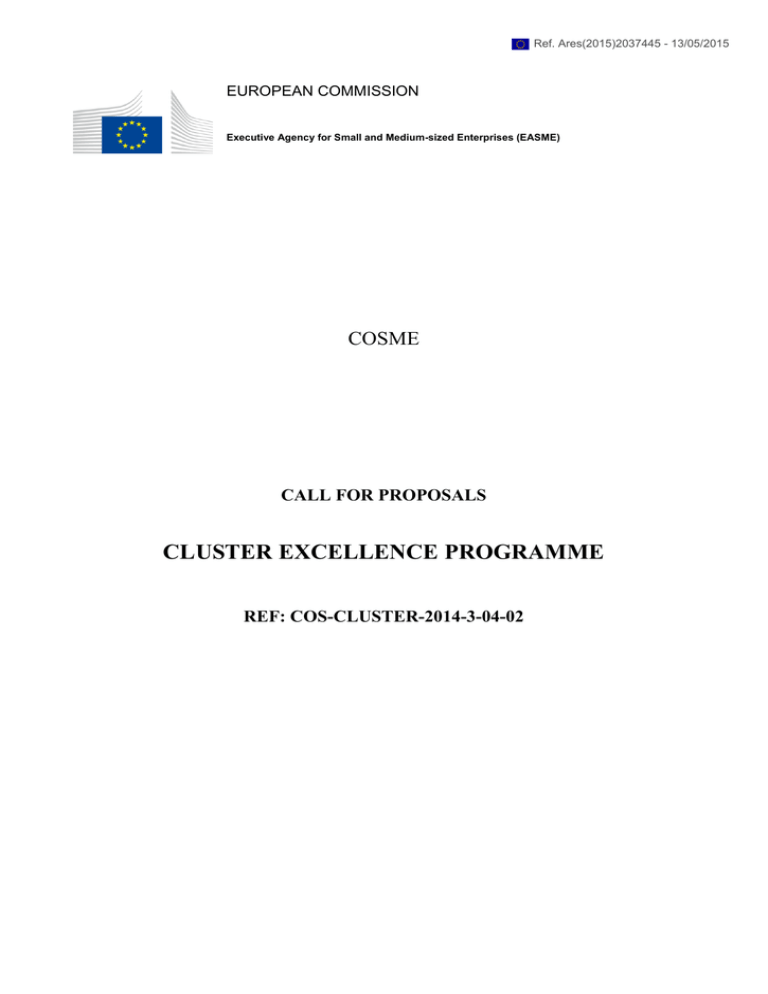
Ref. Ares(2015)2037445 - 13/05/2015 EUROPEAN COMMISSION Executive Agency for Small and Medium-sized Enterprises (EASME) COSME CALL FOR PROPOSALS CLUSTER EXCELLENCE PROGRAMME REF: COS-CLUSTER-2014-3-04-02 Table of Contents 1. INTRODUCTION AND BACKGROUND ............................................................... 4 1.1. Introduction ....................................................................................................... 4 2. OBJECTIVE(S) – THEME(S) – ACTIVITIES – OUTPUTS .................................... 4 2.1. Background ....................................................................................................... 4 2.2. Objectives of the action..................................................................................... 5 2.3. Description of the activities .............................................................................. 5 2.4. Impact indicators for the action ........................................................................ 8 3. TIMETABLE .............................................................................................................. 8 4. BUDGET AVAILABLE AND FUNDING OF PROJECTS...................................... 8 5. ADMISSIBILITY REQUIREMENTS ....................................................................... 8 6. ELIGIBILITY CRITERIA.......................................................................................... 9 7. 6.1 Eligible applicants ............................................................................................. 9 6.2 Eligible consortia .............................................................................................. 9 6.3 Implementation period .................................................................................... 10 EXCLUSION CRITERIA ........................................................................................ 10 7.1. Exclusion from participation:.......................................................................... 10 7.2. Exclusion from award: .................................................................................... 10 7.3. Supporting documents..................................................................................... 11 8. SELECTION CRITERIA ......................................................................................... 11 8.1. Financial capacity ........................................................................................... 11 8.2. Operational capacity ....................................................................................... 12 9. AWARD CRITERIA ................................................................................................ 12 10. LEGAL COMMITMENTS ...................................................................................... 13 11. FINANCIAL PROVISIONS .................................................................................... 13 11.1 General Principles .......................................................................................... 13 11.2 Funding forms ................................................................................................. 15 11.3 Payment arrangements .................................................................................... 17 11.4 Pre-financing guarantee .................................................................................. 18 12. PUBLICITY .............................................................................................................. 18 12.1 By the beneficiaries ......................................................................................... 18 2 12.2 By EASME ..................................................................................................... 18 13. DATA PROTECTION.............................................................................................. 19 14. PROCEDURE FOR THE SUBMISSION OF PROPOSALS .................................. 19 3 1. 1.1. INTRODUCTION AND BACKGROUND Introduction Small and medium-sized enterprises (SME) play a crucial role in reaching the objectives of the Europe 2020 Strategy1. Whereas they are considered as crucial engines for growth and job creation, their competitiveness is affected by a limited exploitation of international opportunities and innovation prospects in the Single Market and beyond. In this context, the Programme for the competitiveness of enterprises and small and medium-sized enterprises (2014-2020)2, hereinafter referred to as “COSME”, aims to promote growth and to strengthen the competitiveness and sustainability of enterprises in the European Union. The contracting authority is the Executive Agency for Small and Medium-sized Enterprises3 (hereinafter referred to as "EASME"). EASME is, inter alia, entrusted by the European Commission with the implementation of, among others, parts of the COSME programme and the Horizon 2020 programme. 2. 2.1. OBJECTIVE(S) – THEME(S) – ACTIVITIES – OUTPUTS Background High quality cluster management is today recognised as a key element of a successful world-class cluster. Strong management is crucial for cluster organisations for providing top professional services to cluster firms, for assisting companies to access global markets successfully, and for raising the innovation capacity and competitiveness of cluster firms in the large sense. The growing number of cluster organisations in the EU today represents various quality levels with respect to their organisation, experience and ambition. Some cluster organisations are well advanced on cluster excellence issues while others are clearly lagging behind. As part of the EU efforts to create more world-class clusters across the EU by strengthening cluster excellence, the Commission launched in 2009, under the Competitiveness and Innovation Programme, the European Cluster Excellence Initiative4 (ECEI). ECEI's main aim was, first, to design, test and validate a benchmarking methodological tool to be used by cluster organisations to identify and improve their internal management process and the way they offer services to cluster firms, and, second, to develop training materials with the ultimate goal to help cluster managers improving their own managerial capability. To validate and apply the benchmarking tool and the training materials developed within the EU initiative, two Calls for proposals have been launched at EU level in this area and eight projects 1 2 COM (2010)2020 final of 3 March 2010 “Europe 2020. A strategy for smart, sustainable and inclusive growth”. Regulation (EU) No 1287/2013 of 11 December 2013 (Official Journal of the European Union L 347/33 of 20.12.2013). 3 EASME was set up by Commission Implementing Decision 2013/771/EU of 17 December 2013 establishing the Executive Agency for Small and Medium-sized Enterprises and repealing Decisions 2004/20/EC and 2007/372/EC (Official Journal of the European Union L 341/73 of 18.12.2013). 4 http://www.cluster-excellence.eu/ 4 have been funded under CIP over the past 3 years. It is important to mention that these two previous calls intended to implement a train-the-trainers scheme and therefore the direct beneficiaries in these projects were officials working in regional or national public organisations managing cluster activities. The present Call for proposals is directly addressed to consortia of cluster organisations or business networks. The action will be implemented by consortia of cluster organisations or business networks operating in COSME participating countries5, and already engaged (or plan to engage) into a strategic industry-driven collaboration. The partners in each selected project will participate in specific benchmarking and training activities dedicated to cluster management to be provided by competent trainers in this area that may use (or be inspired by) the training materials developed in the framework of the European Cluster Excellence Initiative6 co-funded under CIP during the period 2009-2012. 2.2. Objectives of the action The overall objective of this Call for proposals is to pursue the EU efforts aimed to strengthen cluster management excellence in the EU as a way to provide more professional business services to European SMEs through clusters and therefore contribute to the development of more worldclass clusters in the EU. This Call for proposals is the first action in the framework of the Cluster Excellence Programme to be supported under COSME, and aimed to promote cluster excellence across the EU for the benefit of European SMEs involved in clusters. The present action will assist cluster organisations, business networks and their managers to provide high quality services to SMEs in different areas, including access to foreign markets. The interested cluster organisations and business networks should be engaged into a strategic industry-driven collaboration (or are planning to work together) along a common value chain or on a transnational project in any manufacturing or service sector, and are facing some common challenges, and willing to: 2.3. Improve their management practices as well as their market/competitive advantages or valuechain analytical capacities and; Provide top quality services to their SMEs, especially on integrating creativity into their business, facilitating SMEs internationalisation, better exploiting and diffusing Key Enabling Technologies (KETs), assisting SMEs on IPRs protection and further addressing resourceefficiency issues within their cluster. Description of the activities The eligible activities to be supported under this action are provided below: A. Participation in the benchmarking activities All cluster organisations and business networks of the consortium shall participate in the benchmarking exercise aimed to assess their management performance according to the benchmarking methodology developed by the European Cluster Excellence Initiative and currently 5 http://eur-lex.europa.eu/legal-content/EN/TXT/?uri=CELEX:32013R1287 6 http://www.cluster-excellence.eu/ 5 provided by the European Secretariat of Cluster Analysis (ESCA)7. Feedback from the benchmarking experts to cluster managers should include concrete recommendations on how to improve the management of the evaluated cluster organisations and business networks. Expected results and deliverables: Benchmarking of all cluster organisations and business networks involved; Report including concrete, clear, feasible recommendations on how to improve their management process. Eligible costs include: participation in the benchmarking exercise including eventually some travelling costs for the cluster manager. Applicants will have to negotiate a cost-effective price for the services provided by the ESCA experts. Eligible costs include also the costs for obtaining any of the labels provided by the ESCA. B. Participation in the trainings This action will support training activities addressed to consortia of cluster organisations and business networks. As part of their activities, each selected consortium shall prepare and launch an open call for tender at EU level for recruiting the most competent experts providing trainings for cluster managers on issues relevant to cluster excellence. These experts shall come from COSME participating countries, and shall be selected at a best value for money basis. The official procedure to be followed shall be in line with the general financial rules for subcontracting as provided in the project contract. These trainings for cluster managers may use (or be inspired by) the training materials prepared in the framework of the European Cluster Excellence Initiative. Each project shall identify on the basis of the specific needs of the participating cluster organisations which training modules (and case studies) should be followed as part of their training activities. To have a significant impact, each project shall select at least 5 modules from the training package as developed by the European Cluster Excellence Initiative8. Moreover, if necessary, additional training case studies (on top of those currently managed by the European Foundation for Cluster Excellence9) could be developed and supported by the project to cover themes that better correspond to the specific needs of the project partners such as case studies on how to promote cross-sectoral cooperation and facilitate the emergence of new industries through clusters. Expected results and deliverables: Training of maximum two persons per cluster organisation and business network; Report on the lessons learned, and practical recommendations for improving the trainings provided. Eligible costs include: participation in the trainings for maximum two persons from one project partner including travelling costs. Moreover, eligible costs can include the development of specific 7 http://www.cluster-analysis.org/ 8 http://www.clusterexcellence.org/what-we-do-program-content/ 9 http://www.clusterexcellence.org/ 6 new case studies; such activities can be subcontracted in line with the general financial rules for subcontracting to be provided in the project contract. C. Identification of services provided to SMEs and organisation of study visits Each consortium shall collect information about the services provided by each cluster organisation participating in the project or those cluster organisations wish to develop in the future for the benefit of their SMEs. On that basis, each consortium will try to identify, with the assistance of the recruited experts, other cluster organisations in COSME participating countries offering such services in a professional way. Then, all cluster managers involved in the project will have to visit for maximum 4 days these top cluster organisations, preferably located in a different EU Member State, to get useful and practical information on good management practices and better understand how to develop such professional services for their cluster. Expected results and deliverables: Analysis of the services currently provided (or to be developed) by each cluster organisation and business network; Report on the lessons learned from the study visits and recommendations for further similar actions to be developed at EU level. Eligible costs include: all costs related to the identification and analysis of the appropriate services, as well as traveling costs for the study visits of max 4 days for maximum 2 people from each cluster organisation (including the cluster manager). D. Dissemination, impact assessment, and follow up activities The project shall propose in a specific work package the dissemination activities that will be carried out about their work and benefits from investing on cluster excellence activities. This shall include the organisation of some local events and events organised jointly by the project partners. The consortium shall also provide detailed information about the expected outcome of the project. Each project shall develop a strategy and a plan on how they expect to pursue this work on cluster excellence after the end of the project. This shall include concrete information about how cluster excellence activities will be integrated into regional and national programmes. Expected results and deliverables: Dissemination of the project results so that other local cluster organisations and business networks are aware of the benefits of the cluster management excellence approach. Development of measurable indicators to assess the impact of the project work on the operation of the cluster organisations and business networks and the competitiveness of their SMEs. Report on how the project partners envisage working on cluster excellence after the end of the project and which local, regional or European funding programmes can be used to support future activities in this area. Eligible costs include: all costs related to the dissemination activities of the project such as organisation of local and joint events and specific workshops to promote cluster excellence at local level. 7 2.4. Impact indicators for the action Through this action it is expected that a high number of SMEs in clusters and business networks will receive more professional business support services from their respective organisations. Number of cluster organisations, business networks and their managers from different COSME participating countries having been directly involved in the action; Number of SMEs which have indirectly benefited from the supported actions through the provision of more professional services provided by the involved cluster organisations and business networks. 3. TIMETABLE Stages Dates a) Publication of the call 13/05/2015 b) Deadline for submitting applications 16/06/2015 17:00h Brussels time c) Evaluation period June, July, and August 2015* d) Information to applicants September 2015 e) Signature of grant agreements October to December 2015* f) Starting date of the action December 2015* * indicative 4. BUDGET AVAILABLE AND FUNDING OF PROJECTS The total budget earmarked for the EU co-financing for this call is estimated at €1,25 Million. The maximum grant for each project will be 250.000 €. The EASME expects to fund 5 proposals. The grant is limited to a maximum reimbursement rate of 95% of eligible costs. The EASME reserves the right not to distribute all the funds available. 5. ADMISSIBILITY REQUIREMENTS The following requirements must be complied with: Applications must be submitted no later than the deadline for submitting applications referred to in section 3; Applications must be submitted as explained in section 14; Applications must be drafted in one of the EU official languages. A summary in English must be provided in case the proposal is drafted in another language than English. 8 Failure to comply with those requirements will lead to the rejection of the application from the onset and without any evaluation process. 6. ELIGIBILITY CRITERIA Proposals must be submitted by a consortium of applicant organisations fulfilling the below requirements. 6.1 Eligible applicants Applicant organisations must be legal entities. Private bodies must be properly constituted and registered under national law. Legal entities having a legal or capital link with applicants, which is neither limited to the action nor established for the sole purpose of its implementation, may take part in the action as affiliated entities, and may declare eligible costs as specified in section 11.2. For that purpose, applicants shall identify such affiliated entities in the application form. Applicants must submit a description - annexed to the proposal - of each cluster and business network organisation involved as a partner in the project demonstrating that it offers or channels cluster and network support services to businesses in compliance with the definition given in the section 1.3 (s) on 'innovation clusters' in Annex I of the new “EU Framework for State Aid for Research and Development and Innovation”10. Please note that links to the webpages of the partners in the project cannot replace the above-mentioned description. Applicant organisations must be established in EU Member States or in countries participating in the COSME programme under Article 6 of the COSME Regulation11. 6.2 Eligible consortia Consortia implementing the activities have to: be made up of a minimum of three cluster organisations or business network organisations; partners of the consortia must come from at least three COSME participating countries; At least one of the participating partners must be new to benchmarking of cluster management. The latter means that at least one partner will have no previous experience of promoting excellent 10 2014/C 198/01 - according to this definition: ‘innovation clusters’ means structures or organised groups of independent parties (such as innovative start-ups, small, medium and large enterprises, as well as research and knowledge dissemination organisations, non-for-profit organisations and other related economic actors) designed to stimulate innovative activity by promoting sharing of facilities and exchange of knowledge and expertise and by contributing effectively to knowledge transfer, networking, information dissemination and collaboration among the undertakings and other organisations in the cluster; See at: http://eur-lex.europa.eu/legal-content/EN/TXT/PDF/?uri=CELEX:52014XC0627(01)&from=EN with further information available at http://ec.europa.eu/competition/state_aid/modernisation/rdi_framework_en.pdf and http://ec.europa.eu/competition/state_aid/legislation/horizontal.html amending the Community Framework (2006/C 323/01 see at: http://eur-lex.europa.eu/LexUriServ/LexUriServ.do?uri=OJ:C:2006:323:0001:0026:en:PDF), a reference of section 5.8 of which was included in the COSME Work Programme regarding the "innovation clusters" definition 11 The following groups of countries are eligible for participation in COSME: a. European Free Trade Association (EFTA) countries which are members of the European Economic Area (EEA), in accordance with the conditions laid down in the EEA Agreement, and other European countries when agreements and procedures so allow; b. acceding countries, candidate countries and potential candidates in accordance with the general principles and general terms and conditions for the participation of those countries in the Union's programmes established in the respective Framework Agreements and Association Council Decisions, or similar arrangements; c. countries falling within the scope of the European neighbourhood policies, when agreements and procedures so allow and in accordance with the general principles and general terms and conditions for the participation of those countries in the Union's programmes established in the respective Framework Agreements, Protocols to Association Agreements and Association Council Decisions. 9 cluster management and will have not previously acquired any of the ESCA labels granted on cluster management excellence. 6.3 Implementation period The maximum duration of projects is 24 months. Applications for projects scheduled to run for a longer period than that specified in this call for proposals will not be accepted. 7. 7.1. EXCLUSION CRITERIA Exclusion from participation: Applicants will be excluded from participating in the call for proposals procedure if they are in any of the following situations: (a) they are bankrupt or being wound up, are having their affairs administered by the courts, have entered into an arrangement with creditors, have suspended business activities, are the subject of proceedings concerning those matters, or are in any analogous situation arising from a similar procedure provided for in national legislation or regulations; (b) they or persons having powers of representation, decision making or control over them have been convicted of an offence concerning their professional conduct by a judgment of a competent authority of a Member State which has the force of res judicata; (c) they have been guilty of grave professional misconduct proven by any means which the contracting authority can justify including by decisions of the EIB and international organisations; (d) they are not in compliance with their obligations relating to the payment of social security contributions or the payment of taxes in accordance with the legal provisions of the country in which they are established or with those of the country of the Responsible Authorising Officer (RAO) or those of the country where the grant agreement is to be performed; (e) they or persons having powers of representation, decision making or control over them have been the subject of a judgment which has the force of res judicata for fraud, corruption, involvement in a criminal organisation, money laundering or any other illegal activity, where such an illegal activity is detrimental to the Union's financial interests; (f) they are currently subject to an administrative penalty referred to in Article 109(1) of the Financial Regulation12. 7.2. Exclusion from award: Applicants will not be granted financial assistance if, in the course of the grant award procedure, they: (a) 12 are subject to a conflict of interest; Regulation (EU, Euratom) No 966/2012 of the European Parliament and of the Council of 25 October 2012 (Official Journal of the European Union L 298 of 26.10.2012). 10 (b) are guilty of misrepresentation in supplying the information required by the Commission as a condition of participation in the grant award procedure or fail to supply this information; (c) find themselves in one of the situations of exclusion, referred to in section 7.1. The same exclusion criteria apply to affiliated entities. Administrative and financial penalties may be imposed on applicants, or affiliated entities where applicable, who are guilty of misrepresentation. 7.3. Supporting documents Applicants must sign a declaration on their honour certifying that they are not in one of the situations referred to in Articles 106(1) and 107 to 109 of the Financial Regulation13, filling in the relevant form. 8. 8.1. SELECTION CRITERIA Financial capacity Applicants must have stable and sufficient sources of funding to maintain their activity throughout the period during which the action is being carried out or the year for which the grant is awarded and to participate in its funding. The applicants' financial capacity will be assessed on the basis of the following supporting documents: a) Low value grants (≤ EUR 60 000): - a declaration on their honour. b) Grants ≥ EUR 60 000: - a declaration on their honour and, EITHER the profit and loss account, the balance sheet for the last financial year for which the accounts were closed; for newly created entities, the business plan might replace the above documents. OR the table provided for in the application form, filled in with the relevant statutory accounting figures, in order to calculate the ratios as detailed in the form. The above-listed documents will have to be provided at later stage, via an online tool and only upon request of the EASME. The above thresholds apply to each partner in a consortium. 13 Regulation (EU, Euratom) No 966/2012 of the European Parliament and of the Council of 25 October 2012 (Official Journal of the European Union L 298 of 26.10.2012) 11 On the basis of the documents submitted, if the RAO considers that financial capacity is not satisfactory, he may: request further information; propose a grant agreement without pre-financing; propose a grant agreement with a pre-financing paid in instalments; propose a grant agreement with a pre-financing covered by a bank guarantee (see section 11.4 below); where applicable, require the joint and several financial liability of all the co-beneficiaries; reject the application. 8.2. Operational capacity Applicants must have the professional competencies as well as appropriate qualifications necessary to complete the proposed action. In this respect, applicants have to submit a declaration on their honour, and the following supporting documents: A description of each cluster organisation and business network involved as a partner in the project. It should demonstrate that the proposed consortium will provide or channel cluster and network support services to local businesses, in compliance with the definition given in the section 5.8 of the “Community Framework for State Aid for Research and Development and Innovation”; Curriculum vitae or description of the profile of the people primarily responsible for managing and implementing the operation; Curriculum vitae or description of the profile of the people who are expected to participate in the benchmarking exercise and the trainings activities for each partner; A list of previous projects and activities performed in the cluster area and connected to the policy field of the call or to the actions to be carried out. 9. AWARD CRITERIA Eligible applications will be assessed on the basis of the following criteria: EVALUATION CRITERIA AND KEY ELEMENTS LIKELY TO BE ASSESSED BY THE EVALUATION COMMITTEE 1. Relevance of the actions in view of the objectives of the call MAX. SCORE 20 How relevant is the proposal to the objectives of the published theme to promote world-class clusters in the EU? How clearly defined and strategically chosen are the proposed activities in this respect? 2. Quality of the proposed actions 40 How coherent and ambitious is the overall work plan and to what extent does it cover the activities described in the Call ? To what extent is the work plan clearly presented in terms of milestones, deliverables and a sound management structure? 12 3. Impact on target audience 20 What is the expected outcome and potential impact and EU added value of the project and what can be the multiplier effect of the project to further promote cluster excellence in the involved territories? Does the proposal describe how to measure the impact of the project results on the basis of specific indicators? 4. Cost-effectiveness 20 To what extent is the budget clear enough and detailed? Is it necessary to implement all project activities? To what extend is the budget allocation justified per each member of the consortium and activities? Maximum total score 100 In order to be considered for funding proposals will need to have passed an overall threshold of 70% in terms of total score. In addition, thresholds of 50% will be applied to each of the four individual award criteria described above in order to ensure a consistent minimum quality for all award criteria. Proposals will be ranked according to their total score. 10. LEGAL COMMITMENTS In the event of a grant awarded by the Agency, a grant agreement, drawn up in euro and detailing the conditions and level of funding, will be sent to the beneficiary. It will also be informed on the procedure to formalise the obligations of the parties. Please note that the award of a grant does not establish an entitlement for subsequent years. 11. 11.1 FINANCIAL PROVISIONS General Principles a) Non-cumulative award An action may only receive one grant from the EU budget. In no circumstances shall the same costs be financed twice by the Union budget. To ensure this, applicants shall indicate the sources and amounts of Union funding received or applied for the same action or part of the action or for its functioning during the same financial year as well as any other funding received or applied for the same action.14 b) Non-retroactivity No grant may be awarded retrospectively for actions already completed. A grant may be awarded for an action which has already begun only where the applicant can demonstrate the need to start the action before the grant agreement is signed. 14 Directive 2004/18/EC of 31 March 2004 on the coordination of procedures for the award of public work contracts, public supply contracts and public service contracts (Official Journal of the European Union L 134/114 of 30.04.2004). 13 In such cases, costs eligible for financing may not have been incurred prior to the date of submission of the grant application c) Co-financing Co-financing means that the resources which are necessary to carry out the action may not be entirely provided by the EU grant. It may take the form of: the beneficiary's own resources; income generated by the action; financial contributions from third parties. Co-financing may also take the form of in-kind contributions from third parties, i.e. nonfinancial resources made available free of charge by third parties to the beneficiary or to the consortium. The corresponding costs are not eligible. d) Balanced budget The estimated budget of the action is to be attached to the application form. It must have revenue and expenditure in balance. The budget must be drawn up in euros. Applicants, who foresee that costs will not be incurred in euros, are invited to use the exchange rate published on the Info-euro website available at: http://ec.europa.eu/budget/contracts_grants/info_contracts/inforeuro/inforeuro_en.cfm. e) Implementation contracts/subcontracting Where the implementation of the action requires the award of procurement contracts (implementation contracts), the beneficiary must award the contract to the bid offering best value for money or the lowest price (as appropriate), avoiding conflicts of interests and retain the documentation for the event of an audit. Entities acting in their capacity of contracting authorities in the meaning of Directive 2004/18/EC15 or contracting entities in the meaning of Directive 2004/17/EC16 shall abide by the applicable national public procurement rules. The beneficiary is expected to clearly document the tendering procedure and retain the documentation for the event of an audit. Sub-contracting, i.e. the externalisation of specific tasks or activities which form part of the action as described in the proposal must satisfy the conditions applicable to any implementation contract (as specified above) and in addition to them the following conditions: - it may only cover the implementation of a limited part of the action; 15 Directive 2004/18/EC of 31 March 2004 on the coordination of procedures for the award of public work contracts, public supply contracts and public service contracts (Official Journal of the European Union L 134/114 of 30.04.2004). 16 Directive 2004/17/EC of 31 March 2004 coordinating the procurement procedures of entities operating in the water, energy, transport and postal services sectors (Official Journal of the European Union L 134/114 of 30.04.2004). 14 - it must be justified having regard to the nature of the action and what is necessary for its implementation; - it must be clearly stated in the proposal. f) Financial support to third parties. Applications may not envisage provision of financial support to third parties. 11.2 Funding forms Grants are calculated on the basis of a detailed estimated budget indicating clearly the costs that are eligible for EU funding. The grant amount may neither exceed the eligible costs nor the amount requested. Amounts are indicated in euros. Maximum amount requested The EU grant is limited to a maximum reimbursement rate of eligible costs indicated in section 4. Consequently, part of the total eligible expenses entered in the estimative budget must be financed from sources other than the EU grant (see section 11.1c). Eligible costs Eligible costs are costs actually incurred by the beneficiary of a grant which meet all the following criteria: they are incurred during the duration of the action, with the exception of costs relating to final reports and audit certificates; The period of eligibility of costs will start as specified in the grant agreement. If a beneficiary can demonstrate the need to start the action before the agreement is signed, expenditure may be authorised before the grant is awarded. Under no circumstances can the eligibility period start before the date of submission of the grant application (see section 11.1b). they are indicated in the estimated budget of the action; they are necessary for the implementation of the action which is the subject of the grant; they are identifiable and verifiable, in particular being recorded in the accounting records of the beneficiary and determined according to the applicable accounting standards of the country where the beneficiary is established and according to the usual cost accounting practices of the beneficiary; they comply with the requirements of applicable tax and social legislation; they are reasonable, justified, and comply with the requirements of sound financial management, in particular regarding economy and efficiency. The beneficiary's internal accounting and auditing procedures must permit direct reconciliation of the costs and revenue declared in respect of the action/project with the corresponding accounting statements and supporting documents. The same criteria apply to the affiliated entities. 15 Eligible direct costs The eligible direct costs for the action are those costs which, with due regard for the conditions of eligibility set out above, are identifiable as specific costs directly linked to the performance of the action and which can therefore be booked to it directly, such as : - the costs of personnel working under an employment contract with the applicant or equivalent appointing act and assigned to the action, comprising actual salaries plus social security contributions and other statutory costs included in the remuneration, provided that these costs are in line with the applicant's usual policy on remuneration. Those costs may include additional remuneration, including payments on the basis of supplementary contracts regardless of their nature, provided that it is paid in a consistent manner whenever the same kind of work or expertise is required and independently from the source of funding used; - costs of the personnel of national administrations to the extent that they relate to the cost of activities which the relevant public authority would not carry out if the project concerned were not undertaken; - subsistence allowances (for meetings, including kick-off meetings where applicable, conferences etc.) provided that these costs are in line with the beneficiary's usual practices; - costs of travel (for meetings, including kick-off meetings where applicable, conferences etc.), provided that these costs are in line with the beneficiary's usual practices on travel; - depreciation cost of equipment (new or second-hand): only the portion of the equipment's depreciation corresponding to the duration of the action/project and the rate of actual use for the purposes of the action may be taken into account by the EASME; - costs of consumables and supplies, provided that they are identifiable and assigned to the action/project; - costs entailed by implementation contracts awarded by the beneficiaries for the purposes of carrying out the action/project, provided that the conditions laid down in the grant agreement are met; - costs arising directly from requirements linked to the implementation of the action/project (dissemination of information, specific evaluation of the action, translations, reproduction); - costs relating to a pre-financing guarantee lodged by the beneficiary of the grant, where required; - costs relating to external audits where required in support of the requests for payments; - non-deductible value added tax ("VAT"). Eligible indirect costs (overheads) A flat-rate amount of 7% of the total eligible direct costs of the action, is eligible under indirect costs, representing the beneficiary's general administrative costs which can be regarded as chargeable to the action/project. Indirect costs may not include costs entered under another budget heading. Applicants’s attention is drawn to the fact that in the case of organisations receiving an operating grant, indirect costs are not eligible under specific actions. 16 Ineligible costs (a) costs related to return on capital; (b) debt and debt service charges; (c) provisions for future losses or debts; (d) interest owed; (e) doubtful debts; (f) currency exchange losses; (g) bank costs charged by the beneficiary’s bank for transfers from the EASME; (h) excessive or reckless expenditure; (i) deductible VAT; (j) costs incurred during suspension of the implementation of the action; (k) in-kind contributions provided by third parties; (l) costs declared under another EU or Euratom grant (including grants awarded by a Member State and financed by the EU or Euratom budget and grants awarded by bodies other than the EASME for the purpose of implementing the EU or Euratom budget); in particular, indirect costs if the beneficiary is already receiving an operating grant financed by the EU or Euratom budget in the same period. Calculation of the final grant amount The final amount of the grant to be awarded to the beneficiary is established after completion of the action, upon approval of the request for payment containing the following documents: - a final report providing details of the implementation and results of the action; - the final financial statement of costs actually incurred. EU grants may not have the purpose or effect of producing a profit within the framework of the action. Profit shall be defined as a surplus of the receipts over the eligible costs incurred by the beneficiary, when the request is made for payment of the balance. In this respect, where a profit is made, the EASME shall be entitled to recover the percentage of the profit corresponding to the Union contribution to the eligible costs actually incurred by the beneficiary to carry out the action. 11.3 Payment arrangements Pre-financing payment A pre-financing payment corresponding to 70% of the grant amount will be transferred to the beneficiary within 30 days of the date when the last of the two parties signs the agreement, provided all requested guarantees have been received. 17 Final payment The EASME will establish the amount of the final payment to be made to the beneficiary on the basis of the calculation of the final grant amount (see section 11.2 above). If the total of earlier payments is higher than the final grant amount, the beneficiary will be required to reimburse the amount paid in excess by the EASME through a recovery order. 11.4 Pre-financing guarantee In the event that the applicant's financial capacity is not satisfactory, a pre-financing guarantee for up to the same amount as the pre-financing may be requested in order to limit the financial risks linked to the pre-financing payment. The financial guarantee, in euro, shall be provided by an approved bank or financial institution established in one of the Member State of the European Union. When the beneficiary is established in a third country, the RAO may agree that a bank or financial institution established in that third country may provide the guarantee if he considers that the bank or financial institution offers equivalent security and characteristics as those offered by a bank or financial institution established in a Member State. Amounts blocked in bank accounts shall not be accepted as financial guarantees. The guarantee may be replaced by a joint and several guarantee by a third party or by a joint guarantee of the beneficiaries of an action who are parties to the same grant agreement The guarantee shall be released as the pre-financing is gradually cleared against interim payments or payments of balances to the beneficiary, in accordance with the conditions laid down in the grant agreement. 12. PUBLICITY 12.1 By the beneficiaries Beneficiaries must clearly acknowledge the European Union’s contribution in all publications or in conjunction with activities for which the grant is used. In this respect, beneficiaries are required to give prominence to the name and emblem of the European Commission and EASME on all their publications, posters, programmes and other products realised under the co-financed project. To do this they must use the text, the emblem and the disclaimer in accordance with the details provided in the grant agreement. If this requirement is not fully complied with, the beneficiary's grant may be reduced in accordance with the provisions of the grant agreement. 12.2 By EASME With the exception of scholarships paid to natural persons and other direct support paid to natural persons in most need, all information relating to grants awarded in the course of a financial year shall be published on an internet site of the European Union institutions no later than the 30 June of the year following the financial year in which the grants were awarded. 18 The EASME will publish the following information: - name of the beneficiary - address of the beneficiary when the latter is a legal person, region when the beneficiary is a natural person, as defined on NUTS 2 level17 if he/she is domiciled within EU or equivalent if domiciled outside EU, - subject of the grant, - amount awarded. Upon a reasoned and duly substantiated request by the beneficiary, the publication shall be waived if such disclosure risks threatening the rights and freedoms of individuals concerned as protected by the Charter of Fundamental Rights of the European Union or harm the commercial interests of the beneficiaries. 13. DATA PROTECTION The reply to any call for proposals involves the recording and processing of personal data (such as name, address and CV). Such data will be processed pursuant to Regulation (EC) No 45/200118 on the protection of individuals with regard to the processing of personal data by the Community institutions and bodies and on the free movement of such data. Unless indicated otherwise, the questions and any personal data requested are required to evaluate the application in accordance with the specifications of the call for proposal will be processed solely for that purpose by the Head of Unit A.1 of the EASME. Details concerning the processing of personal data are available on the privacy statement at: http://ec.europa.eu/research/participants/data/support/legal_notice/h2020-sspsgrants_en.pdf Personal data may be registered in the Early Warning System (EWS) only or both in the EWS and Central Exclusion Database (CED) by the Accounting Officer of the Commission, should the beneficiary be in one of the situations mentioned in: - the Commission Decision of 13 November 2014 on the Early Warning System to be used by the authorising officers of the Commission and by the executive agencies (2014/792/EU) OJ 2014 L 329 of 14 November, p.68 e (for more information see the Privacy Statement on: http://ec.europa.eu/budget/contracts_grants/info_contracts/legal_entities/legal_entities_en.cfm ), or - the Commission Regulation 2008/1302 of 17.12.2008 on the Central Exclusion Database (for more information see the Privacy Statement on http://ec.europa.eu/budget/explained/management/protecting/protect_en.cfm). 17 18 Commission Regulation (EC) No 105/2007 of 1 February 2007 amending the annexes to Regulation (EC) No 1059/2003 of the European Parliament and of the Council on the establishment of a common classification of territorial units for statistics (NUTS) (Official Journal of the European Union L 39 of 10.02.2007). Official Journal of the European Union L 8/1 of 12.01.2001. 19 14. PROCEDURE FOR THE SUBMISSION OF PROPOSALS Proposals must be submitted in accordance with the formal requirements and by the deadline set out under section 3. No modification to the application is allowed once the deadline for submission has elapsed. However, if there is a need to clarify certain aspects or for the correction of clerical mistakes, the EASME may contact the applicant for this purpose during the evaluation process. Applicants will be informed in writing about the results of the selection process. Electronic submission Applicants are requested to go to http://ec.europa.eu/easme/en/cosme-eu-programmecompetitiveness-enterprises-and-small-and-medium-sized-enterprises-smes and follow the procedure for submitting an application. Contacts The EASME is available to answer questions relating to the content of the present call for proposals. All questions must be sent by e-mail to EASME-COSME-CLUSTER-EXC-CALL-2014. Answers will be published at http://ec.europa.eu/easme/cosme_en.htm 20
